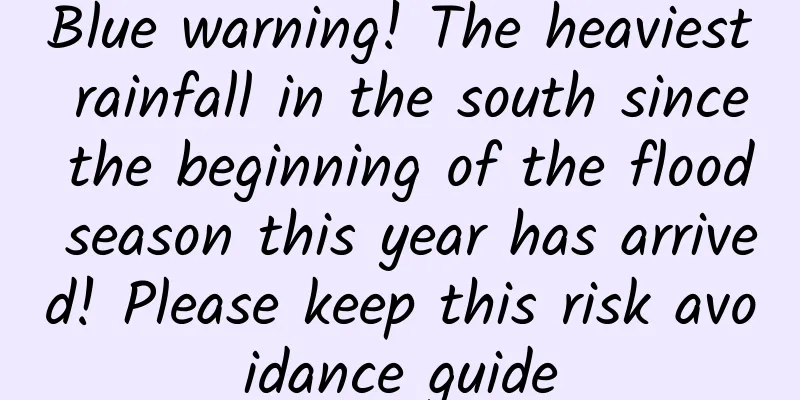Blue warning! The heaviest rainfall in the south since the beginning of the flood season this year has arrived! Please keep this risk avoidance guide

|
Starting today (May 9), the south will experience a new round of heavy rainfall. It is expected that in the next five days, large-scale and intense rainfall will occur in many places, accompanied by short-term heavy rainfall, thunderstorms, strong winds and other strong convective weather. Heavy to torrential rains will occur in 6 provinces, autonomous regions and municipalities Local rainfall in Guangdong and Guangxi may break historical extremes According to the Central Meteorological Observatory forecast: From 08:00 on May 9 to 08:00 on May 10, parts of southern Chongqing, central and eastern Guizhou, most of Hunan, eastern Yunnan, northern Guangxi and northwestern Fujian will experience heavy to torrential rain. Among them, parts of southeastern Guizhou and northern Guangxi will experience torrential rain (100-140 mm). Some of the above-mentioned areas will be accompanied by short-term heavy rainfall (maximum hourly rainfall of 20-50 mm, exceeding 60 mm in some areas), and strong convective weather such as thunderstorms, gales or hail in some areas. This round of precipitation in the south is characterized by long duration, large accumulated rainfall, and local heavy rain. Southern Jiangnan and South China will experience the heaviest rainfall this year. Local daily rainfall in Guangdong and Guangxi may break historical extremes, and local residents need to take precautions. A new round of severe cold air is coming online Temperatures in Northeast China and North China dropped by more than 10°C After the May Day holiday, cold air became active and the weather in many parts of the north turned cooler. Yesterday, the temperature in the eastern part of the Northwest and the North China Plain continued to drop, with the highest temperature in Taiyuan and Shijiazhuang being only around 12°C, which is rare in the same period of history. Starting tomorrow, a new strong cold air will bring strong winds and cooling temperatures to affect the northern regions. It is predicted that from the 10th to the 13th, the temperature in most areas of Northwest China, Inner Mongolia, Northeast China, and North China will drop by 4 to 8℃, and locally by more than 10℃, accompanied by a northerly wind of 4 to 6 levels and gusts of 7 to 9 levels. How to respond to heavy rain and floods? Keep this risk avoidance and self-rescue guide, it can save your life at the critical moment! 01 Self-help in outdoor areas and in urban and rural public areas When strong water flows in the visible area, you should immediately determine whether a flood disaster has occurred. If a flood disaster is determined, take shelter immediately:
1. Squares with higher terrain, and areas above the second floor of solid multi-storey or high-rise public buildings (above water surface). 2. Avoid taking shelter on bridges, especially those over rivers, as flooding in rivers may destroy the bridges.
1. Avoid climbing onto river embankments and other flood control facilities, as extremely strong floods may break down or overflow the embankments. 2. Avoid entering the underground part of the building to prevent water from flooding into the ground. 3. Avoid entering facilities such as subways. 4. Do not enter underground culverts, street tunnels, etc. 5. Do not enter underground civil defense projects. 6. Do not enter the underground shopping street. 7. Avoid being near old buildings. 8. Stay away from hillsides. Heavy rain may cause secondary disasters such as mudslides. 9. Do not stand under or next to trees, and do not get close to billboards. 10. Do not stand on a downhill slope or behind a car. It would be very dangerous if water rushes down and hits both the car and the water. 11. Don’t wear slippers or sandals, and don’t go barefoot, as it’s easy to get injured and slip when wading in water.
1. Don’t drive around. During heavy rain, the ground conditions are completely covered and it is impossible to accurately judge the water accumulation situation. Once you slide into the lowlands, it is very dangerous. 2. Leave public transportation facilities as soon as possible. Public transportation facilities are also dangerous during heavy rains. Buses, subways, taxis, and even high-speed trains may be interrupted. Subways that are suspended underground and buses in low-lying areas are very dangerous. Leave the transportation and find a safe place. 3. If you leave a vehicle, it is best to act as a group. All passengers should evacuate together, preferably holding hands to ensure that no one is left behind. 4. In heavy rain, when actively looking for a safe place, do not rush to make phone calls, post to Moments, take selfies, play with your phone, etc. Rainwater may damage your phone and consume the battery too early, which may have serious consequences. 5. Find a high ground and use your phone to contact the outside world while ensuring your own safety.
1. During the evacuation process, you must stay away from power facilities, high-voltage lines, high-voltage towers, transformers, and all items with power supply hazard signs. 2. Stay away from wires and rope-like objects. 3. Stay away from switches and distribution boxes. 4. Do not touch sockets, switches and other electrical equipment unless you can ensure that your body and hands are dry. 5. Avoid standing in high places in the open air to avoid being struck by lightning.
1. When in danger outdoors, make sure your phone can last until rescuers arrive and that you are able to contact your family and friends after you are safe, so save electricity! 2. When leaving the vehicle, you can send a message to your relatives and friends, whether on WeChat or Moments, marking your location, the location of the vehicle, your evacuation plan, and then evacuate with everyone. 3. After arriving at a safe location, send another message to mark your current location and the situation of the people around you, inform everyone that you are temporarily safe, and reduce contact with the outside world in order to save electricity. 4. If the surrounding water conditions make it impossible for you to leave, you can immediately report to the police your location, how many people are there, the surrounding water conditions, emergency communication methods, etc., then stop using your mobile phone and wait for rescue. 5. If the surrounding environment supports you to charge your mobile phone, or you have extra power banks, you can charge it immediately, but reduce the use of your mobile phone. 6. Whenever possible, confirm the safety of your relatives and friends, provide them with necessary guidance, and ask them to save electricity. 7. After your relatives and friends have reached a safe location, agree on a low-frequency contact plan of communicating every 2-4 hours or longer to reduce each other's communication consumption. 8. In the event of a disaster, the surrounding power and signals may be interrupted, and there may also be signal congestion due to concentrated communications among the entire population. Do not panic when encountering such a situation. Try to get in touch with the public security department, inform them of your difficulties, and wait for government assistance. 9. If you have a radio, you can use it to listen to government announcements. 02 Community self-help and home self-help 1. When a disaster strikes, the neighborhood committee is the grassroots government closest to you. Actively contact the neighborhood committee, your building manager, and your unit manager to quickly form a resident self-help group. 2. People on the lower floors should prepare for evacuation immediately. If the water has not flooded into the unit, you can use this time to prepare for the evacuation of people and organize the materials that need to be carried. 3. The elderly, the weak, and the sick need to be relocated in advance. If possible, apply to live with neighbors on higher floors. If it is inconvenient, you can temporarily settle in the corridors or stairs on higher floors. 4. People who need to use ventilators and oxygen cylinders should move their life-support equipment out in time and apply for access to the neighbor's circuit to ensure that they can survive when the power supply is normal. Inflate the spare oxygen bag in time to ensure that they can still get emergency oxygen supply after the power outage. 5. Prepare necessary supplies for the elderly, children and the sick in advance. 6. Cut off the power supply in your home to prevent water from entering your home and causing short circuits in equipment and wires, which could result in electrical fires. 7. Unplug the power cords of household appliances. 8. Turn off gas switches at all levels to avoid gas leakage. 9. Carry your mobile phone, charging cable, and power bank with you to ensure communication capabilities. 10. If you are a radio enthusiast with walkie-talkies and small radio stations, please bring them with you and inform community members, as these may become particularly important rescue communication equipment. 11. If you have a portable radio and batteries at home, please bring them with you. This will not only ensure that you can get information from the outside world, but also help your neighbors and the community. 12. Close doors and windows to avoid water entering. 13. You can carry some spare food with you, such as biscuits, instant noodles, etc. 14. If you have swimming rings, inflatable boats, inflatable beds, etc. at home, you can bring them with you. 15. You can carry with you fruit knives, scissors, band-aids, topical disinfectants, antibiotics, and medicines for daily use by your family. 16. Carry a lighter. 17. If you have rescue ropes or something like that, bring them along as well. 18. Under the organization of the community, a team that is good at using tools can be organized to make some reinforcement or waterproofing facilities. 03 Self-help of enterprises and institutions 1. When heavy rain and floods come, it is not necessary to require all employees to be on duty. Instead, they should be organized to evacuate to a safe location in a timely manner and actively respond to the next stage of the situation. 2. Enterprises and institutions should actively use the relief supplies they have if they can ensure safety, manage and distribute relief supplies well, and provide necessary support to people in nearby areas while ensuring their own safety. 3. If enterprises and institutions have identified safe venues (such as squares with higher terrain, houses that can accommodate more people, etc.), they can actively prepare to open and accept people seeking shelter. 4. Enterprises and institutions can organize their own security teams to be responsible for the order management within their own properties and jurisdictions, and try to get in touch with the local public security department, report the on-site situation to the public security department in a timely manner, and obtain relevant guidance. 5. While ensuring safety, enterprises and institutions should try to open up channels around themselves, use their own communication facilities, information release facilities and outdoor facilities, release information to the outside world, and inform them of their own safety conditions, personnel conditions, available venues, and available materials. 6. Whenever possible, try to ensure that water, food, food, sanitary products, etc. are stored in advance. In addition to ensuring that the personnel stationed in the unit can use them, they can also rescue those in need when necessary. 04 Public warning and preparedness 1. Immediately release disaster information through various means, including the Internet, television, radio, air raid sirens, mobile vehicles, mobilization of enterprises and institutions, and community mobilization. 2. Public warnings should include forecasts and explanations of the time, intensity, and possible disasters of rainstorms, and, where possible, provide self-rescue guidance. 3. Release an emergency hotline and ensure it is accessible. 4. Flood prevention and rescue organizations, personnel and facilities are in place, and command systems at all levels are unobstructed. 05 How to escape when trapped in a car with water while driving? If a vehicle is trapped by water, the following measures can be taken according to the water level. When you first enter a flooded section, open the central lock in time to prevent it from malfunctioning after being submerged in water. If you can open the door, open it quickly to escape. When the water level reaches 1/3 of the car door, the door is easy to push open and you can directly open the door to escape. But when the water level has reached the car window but not higher than the window, the door cannot be opened and you can escape through the sunroof or roll down the side window glass. When a vehicle sinks into the water, the front of the vehicle will reach the bottom of the water first, and air will accumulate in the rear of the vehicle. You should escape to the rear of the vehicle and use the air at the rear to sustain your life. Take a deep breath, open the door or smash the window to escape. 06 What are the self-rescue equipment for heavy rain? In case of floods, try to prepare emergency items such as food, drinking water, flashlights, first aid medicines, etc. Residents living in areas prone to mountain torrents and floods should always have wireless equipment, such as a radio, to receive information from the outside world as soon as possible. Be sure to remember the above self-rescue guide for heavy rainfall weather, and don’t panic in an emergency. In addition to self-rescue, the public also needs to understand the rescue channels. Self-rescue + seeking help are the best double insurance for safety and risk avoidance. Pay more attention to early warning and forecast information, and learn some defense tips, which can save lives in emergencies! Comprehensive sources: Xinhuanet, CCTV News, China Meteorological Center, China Weather Network, etc. |
<<: Zhoushan's thrilling "blood-red sky" has become a hot topic! Is it a UFO landing?
Recommend
BYD's monthly sales of new energy vehicles exceeded 30,000, and it has no plans to stop producing fuel vehicles
Recently, the automobile production and sales dat...
A comprehensive review of China's mobile internet advertising in 2019
The most important turning point is that with the...
What do the two world records of 64-bit and 7.5mm Skyworth GLED Air mean?
January 2 (Reporter Zhang Xiaodong) 64-bit is a n...
How to quickly increase followers on Weibo? Tips for increasing followers on Weibo!
How can Weibo operators increase followers quickl...
New Media Marketing in the Medical Beauty Industry
After the epidemic, medical beauty institutions h...
The Yanjiao explosion accident sounded the alarm: knowing burn first aid knowledge in advance can "save lives"
On March 13, an explosion occurred in a shop in a...
Counting the 10 greatest algorithms of the 20th century
Reference: The Best of the 20th Century: Editors ...
How to implement a lock screen widget for our App
One of the most requested features of iOS is a cu...
Excellent young scientists used to play mahjong as a toy when they were young
In all walks of life, there are young people who ...
Shi Qijia_100 Lectures on Psychological Parenting: Interpreting the Behavioral Codes of Children Aged 0-6 Baidu Cloud Download Course
Shi Qijia_100 Lectures on Psychological Parenting...
In 2023, Apple paid TSMC $17.52 billion, accounting for 25% of TSMC's total revenue.
Recently, according to media reports, in 2023, Ap...
Why doesn't anyone like your ad?
I have been thinking about a question recently. I...
Achieve a net profit of 4000+, one of the money-making opportunities in 2020
Whenever I see a baby a few months old being infe...
Detailed explanation of WeChat business agent model | 3 core agent models revealed
I have to say that’s a great question and one I’m...









